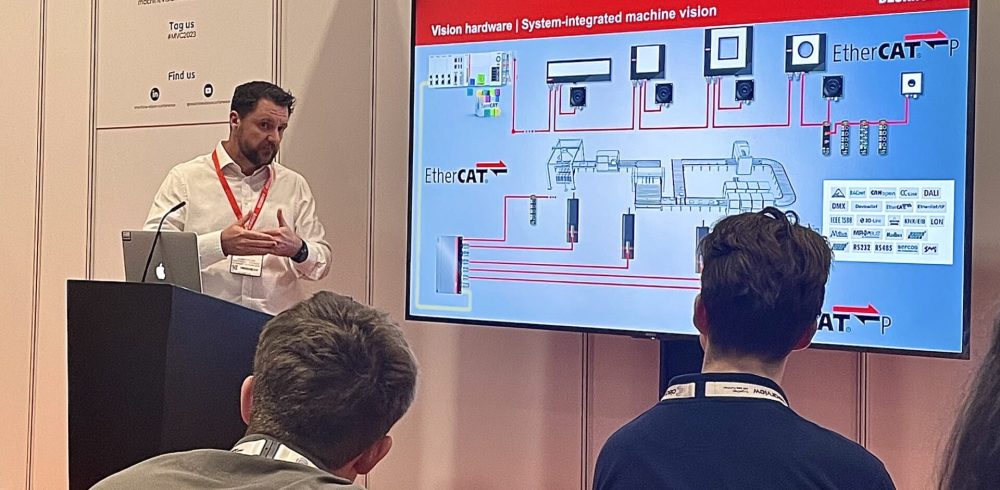Renowned for having the most sophisticated vision across the animal kingdom, the mantis shrimp possesses a visual system that far surpasses human capabilities. While we may not be able to replicate its vision system directly, understanding its remarkable features can inspire us to push the boundaries of manufacturing vision systems. In this article, Adam Carless, vision product specialist at automation and control technology specialist, Beckhoff UK, argues why vision hardware should be tailored to meet the unique requirements of your automation environment.
Zebra’s recent Automotive Ecosystem Vision Study has revealed that 73 per cent of industry decision-makers think their business will be at a competitive disadvantage if they do not embrace more digital technologies, with ‘developing software expertise’ cited as a top five investment priority.
In fact, the original equipment manufacturers (OEMs) who were surveyed in the study said they expect to see usage in industrial machine vision increase by 83 per cent — that’s between now and 2027.
Vision software plays a crucial role in automation environment as it enables machines to perceive and understand their surroundings visually. However, integrating and designing vision software for an automated process can be problematic, due to the complexity of ensuring compatibility and synchronisation between the vision system and existing automation components.
Yet, vision hardware must be designed with specific modifications in mind, which are suited to the system architecture and involves the integration of data exchange for speed and accuracy.
Complexity yields results
Historically, data acquisition within computer vision has been limited by the manual interpretation of captured image data. However, the introduction of deep learning – a type of machine learning based on artificial neural networks – has generated data driven models that could replace handcrafted preprocessing and feature extraction.
Today, vision is very challenging but adds enormous capability. It now involves the use of cameras, image sensors and specialised software to capture, process and analyse visual data. By tailoring it to your automation needs, companies can enhance the capabilities of their automated systems and improve overall operational efficiency.
In fact, according to Deloitte, adopting computer vision, automation and other smart factory initiatives accelerate manufacturing cycles, resulting in a 12 per cent growth in labour productivity and 10 per cent in total production output.
By streamlining operations and working in collaboration with human workers, vision software achieves this through various means. Firstly, it automates inspection processes, eliminating the need for manual inspections and reducing cycle times, and can quickly detect defects, measure dimensions and perform quality checks, thereby expediting the production process.
The software also enables real-time monitoring and data analysis, allowing manufacturers to identify bottlenecks, optimise workflows and make informed decisions swiftly. Finally, machine vision capabilities are also enhanced to ensure faster and more accurate equipment alignment, part recognition and assembly verification.
Your vision
Choosing the right algorithms for image analysis and object recognition is crucial for accuracy in the automated process.
However, algorithms have varying performance characteristics and computational requirements, meaning that designers need to evaluate and optimise algorithms to ensure they can process images quickly enough to meet the desired cycle times, while maintaining accuracy.
Real-time processing is synonymous with the assembly process, especially when identifying and analysing parts. For instance, continuing with the automotive sector, paint inspection typically occurs on a production line with high throughput. This means that vision software is not only critical for processing images, but for ensuring immediate feedback and to prompt rejection of defective car parts at the required speed and accuracy.
Overcoming these challenges in designing and integrating vision software requires expertise in image processing, machine learning and an understanding of the specific requirements and constraints of the manufacturing environment. Collaboration between domain experts, vision system integrators and software developers are crucial to addressing these problems effectively.
By leveraging the expertise of a software and hardware manufacturer, such as Beckhoff UK, vision software can be integrated to ensure precise assembly, detect defects and maintain quality standards during your assembly and inspection process.
In our aforementioned automotive example, Beckhoff’s EtherCAT-based cameras systems can inspect a range of parts during the assembly process. From engines and transmissions to electrical systems, the vision software provides analysis to verify correct positioning, alignment and presence of specific features.
The system also helps to detect defects, scratches or other imperfections on painted surfaces, be it glass or plastic car parts. Here, the TwinCAT vision software analyses these images using algorithms for image recognition and defect classification, allowing any defective components to be automatically rejected, sent for further inspection or rework.
As we explore the untapped potential of vision systems in manufacturing, we pave the way for increased automation, improved quality control and a more efficient and productive landscape. The mantis shrimp’s vision serves as a reminder that nature continues to inspire us all, urging us to redefine the limits of our own technological achievements to enhance the capabilities of our automated systems and improve overall operational efficiency.
For more information about Beckhoff’s secure communication protocol, TwinCAT, and other control technology, visit www.beckhoff.com.
Manufacturing & Engineering Magazine | The Home of Manufacturing Industry News















